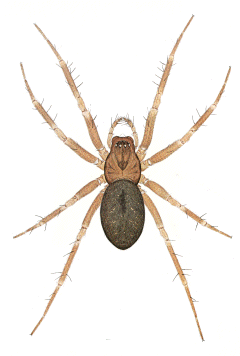

In wet habitats, such as peat-bogs, marshes, wet woodland, etc., this species can be very plentiful in pitfall catches around this time of year. This can help to speed up matters if you're working your way through a lot of samples. However, there is a snag - another species, Centromerita concinna, is fairly similar in appearance and can also be taken in similar places, so you have to watch out for the occasional "odd one out".
In some locations it's C. concinna which is most numerous, with just the occasional specimen of C. bicolor. You can't even rely on the precise habitat to give you some indication, either, as both species can be found in a variety of (usually wet) habitats.
Once again, we have a pair of very similar looking species. Perhaps
they are sibling species, just recently separated by evolutionary processes
of speciation, so they haven't had time to develop strong morphological
differences. We saw this kind of situation in October's
spider, and there are lots of other examples to be found.
So, how do you tell them apart? Well, their overall appearance in similar, but the carapace of C. concinna females is usually a paler yellow in colour than C. bicolor. The males are similar in appearance to their conspecific females and while C. bicolor has lots of stout, forward-pointing hairs around its eyes, there are only a few such hairs in C. concinna. There isn't much difference in size either, although both sexes of C. bicolor are 3-3.5mm in length and so larger than C. concinna with females at 2-3mm and males only 2-2.7mm long.
There are also differences in the spines on the legs, but we have to rely principally on the genitalia to differentiate between these species.
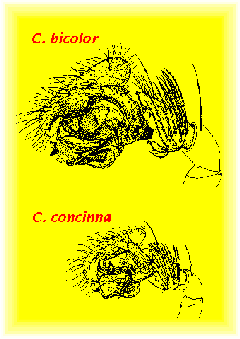
The male palps differ in size as shown here, and also show more subtle
structural differences.
Once your eye has been attuned to these differences, the process of
determining these species becomes speedier.
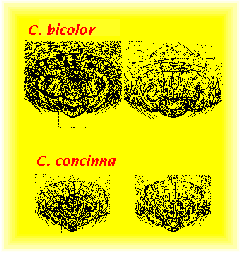 There
is much variation in the appearance of the female's epigyne in both species,
but again a size difference which can be used in terms of the width of
the scape (0.11-0.13mm in C. bicolor and 0.083-0.09mm in C. concinna,
so you really need a good measuring graticule in your microscope!).
There
is much variation in the appearance of the female's epigyne in both species,
but again a size difference which can be used in terms of the width of
the scape (0.11-0.13mm in C. bicolor and 0.083-0.09mm in C. concinna,
so you really need a good measuring graticule in your microscope!).
You can also see that the anterior lip of the epigyne is different: in C. concinna it is a simples convex curve, but in C. bicolor there is also a distinct lobe on each side - obvious once you've spotted it!
So we have to be quite careful in distinguishing between these two species.
When dealing with large numbers of specimens in pitfall samples,
we sometimes come across some "unfortunate" looking spiders.
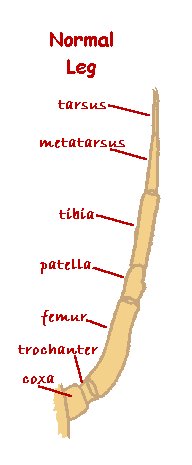
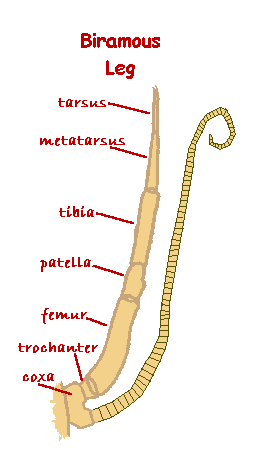 On
closer examination, however, these threads seemed to have a segmented structure
(and nematodes are not segmented) and I realised that they did not "emerge
from the spider's body" but were in fact attached to the base of the spider's
limbs. For each of the walking legs and the palps, the limb was biramous,
i.e. had two branches. The normal structure of a spider's leg is shown
in the picture on the left. Compare this with the anomalous structure of
the leg in our weird specimen, shown on the right. The basal segment of
the limb, the coxa not only had the normal limb articles attached, but
also an apparently undifferentiated whip-like appendage
On
closer examination, however, these threads seemed to have a segmented structure
(and nematodes are not segmented) and I realised that they did not "emerge
from the spider's body" but were in fact attached to the base of the spider's
limbs. For each of the walking legs and the palps, the limb was biramous,
i.e. had two branches. The normal structure of a spider's leg is shown
in the picture on the left. Compare this with the anomalous structure of
the leg in our weird specimen, shown on the right. The basal segment of
the limb, the coxa not only had the normal limb articles attached, but
also an apparently undifferentiated whip-like appendage
It is interesting to note that the primitive condition of arachnid legs is biramous, but in the course of phylogeny (evolution) the limbs have become uniramous, with a single structure. This is reflected in the course of ontogeny (embryological and larval development) where the limbs start off as biramous but very quickly develop the typical uniramous arrangement. You can relate this to the primitive number of spinnerets (8), which develop from the limbs of somites 4 and 5 of the abdomen: i.e. two pairs of rudimentary limbs (= 4) each of these limbs being biramous (= 8); in many species, of course, there are deviations from this primitive number of spinnerets with reduction in number and/or replacement by the cribellum (see November's spider, Amaurobius similis).
I speculate that a possible explanation of our weird spider is that the gene responsible for the biramous limb condition has failed to be switched off, resulting in its expression as the second branch to the limb which is normally suppressed.
.
The pictures of C. bicolor and the genitalia are adapted from
Dr. Mike Roberts' book : The Spiders of Great Britain and Ireland,
published by Harley Books in 1985. You are recommended to refer to that
book for more details of the differences between these species.
| Return to..? | |
 Ariadne Home Page
Ariadne Home Page |
|